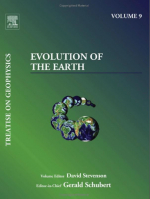Добрый день, Коллеги. Важное сообщение, просьба принять участие. Музей Ферсмана ищет помощь для реставрационных работ в помещении. Подробности по ссылке
Treatise on geophisics. Evolution of the Earth. Volume 9 / Трактат о геофизике. Эволюция земли. Том 9
Evolutionary science is for the most part based on observation and indirect inference. It is not experimental science, even though experiments can certainly play a role in our understanding of processes. We can never hope to have the resources to build our own planet and observe how it evolves; we cannot even hope (at least in the foreseeable future) to observe an ensemble of Earth-like planets elsewhere in the universe and at diverse stages of their evolution (though there is certainly much discussion about detection of such planets; e.g., Seager (2003)). There are two central ideas that govern our thinking about Earth and its history. One is ‘provenance’: the nature and origin of the material that went into making Earth. This is our cosmic heritage, one that we presumably share with neighboring terrestrial planets, and (to some uncertain extent) we share with the meteorites and the abundances of elements in the Sun. The other is ‘process’: Earth is an engine and its current structure is a consequence of those ongoing processes, expressed in the form it takes now. The most obvious and important of these processes is plate tectonics and the inextricably entwined process of mantle convection. However, this central evolutionary process cannot be separated from the nature of the atmosphere and ocean, the geochemical evolution of various parts of Earth expressed in the rock record, and life. Figure 1 shows conceptually the ideas of Earth evolution, expressed as a curve in some multidimensional space that is here simplified by focusing on two variables (‘this’ and ‘that’), the identities of which are not important. They could be physical variables such as temperature, or chemical variables (composition of a particular reservoir) or isotopic tracers. The figure intends to convey the idea that we have an initial condition, an evolutionary path, and a present state. The initial condition is dictated not only by provenance but also by the physics of the formation process. By analogy, we would say that the apples from an apple tree owemuch of their nature not only to the genetics of apples (the process of their formation) but also, to some extent, the soil and climate in which the tree grew.We are informed of this initial condition by astronomy, which tells us about how planets form in other solar systems, by geochemistry (a memory within Earth of thematerials and conditions of Earth formation), and by physical modeling: simulations and analysis of what may have occurred. Notably, we do not get information on the initial condition from geology since there are no rocks or landforms that date back to the earliest history of Earth. Geology, aided by geochemistry and geobiology, plays a central role informing us about Earth history. Though some geophysicists study evolution, nearly all geophysical techniques are directed toward understanding a snapshot of present Earth, or a very short period prior to present Earth, and it is only through modeling (e.g., of geological data) that the physical aspects of evolution are illuminated.




